The last light German cruisers: The Leipzig class represented the last two light cruisers of the German Reichsmarine (and Kriegsmarine). Same class but the second, KMS Nürnberg, was built to a slightly modified design and is sometimes seen separately by some authors. They clearly had sets of improvements over the “K” (Königsberg) class cruisers, larger and with a more efficient main battery arrangement, and better armor. Nürnberg was completed in 1935, both were used during WW2 as minelayers and escort vessels and both were torpedoed 13 December 1939 by the British submarine HMS Salmon. Surviving and repaired, they missed the Norwegian Campaign (perhaps for their own good) and were used in secondary roles for most of the rest of the war, mirroring the rest of Raeder’s surface fleet.
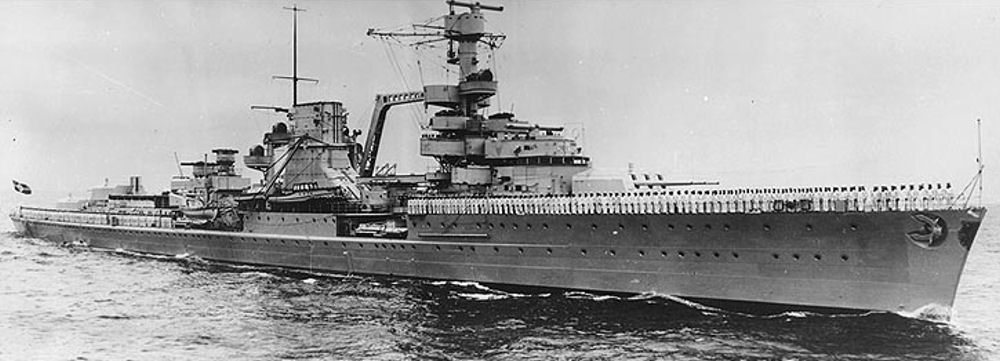
Design of the Leipzig class
Before going into design differences between the two sister-ship, let’s have a look on their similarities, compared to the previous “K” (Königsberg) class. First off, they displaced 1500 tonnes more, up to 9960 short tonnes fully laded versus 7,700 long tons (7,800 t) for the previous cruisers. They had the same beam at 16.3 m versus 15.3 on the previous ships, but their initial length before revision was 177 m (581 feets) overall, versus 174 m (571 feets). In fact, Nürnberg reached 181.3 m (595 feets) after design changes, giving her an even better lenght-to-ratio and preserving top speed.
Hull and armour protection
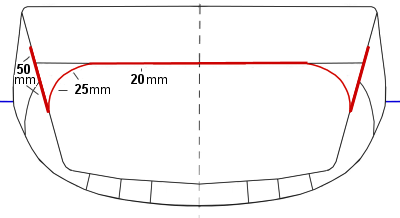
Leipzig’s cut showing its internal armour arrangement
Like previous cruisers, construction called for welding for 90% on the longitudinal steel frames in order to save weight. They also had a comprehensive ASW compartimentation. The hull was indeed divided into fourteen watertight compartments and a double bottom extending on 83% of the length. The also had side bulges and a bulbous bow.
Armour protection only varied in details: The Belt was the same in thickness at 50 mm (2 in) the armoured deck was even thinner at 30 mm (40 mm (1.6 in) on the ‘K’), the Conning tower had the same 100 mm (3.9 in) walls, but the turrets had now 80 mm (3.1 in) faces with Barbettes 60 mm (2.4 in) thick. Both the Leipzig and Nürnberg had the same armored deck 30 mm (1.2 in) thick amidships and 50 mm (2.0 in) belt, inclined downwards however to a greater degree than for the Königsberg for better effectiveness. It was connected to the deck with a 25 mm (0.98 in) stray. The conning tower roof was 50 mm thick. The gun turrets had 35 mm (1.4 in) sides and 32 mm (1.3 in) roofs, but 80 mm faces after revision on the Leipzig. Both ships however diverged in detail: KMS Leipzig had Krupp cemented armor, but Nürnberg received the newly developed “Wotan” Hart steel.
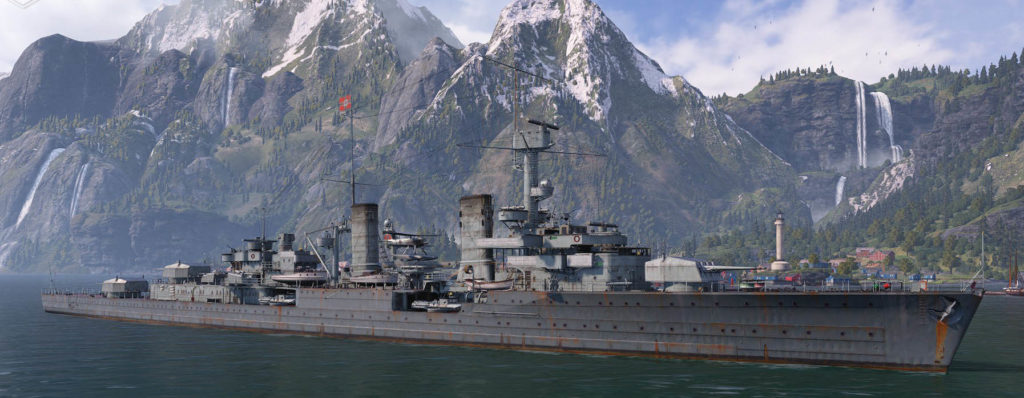
Wow’s rendition of the Koenigsberg class
Powerplant
Machinery was slightly different, although relying on the same principle of combining turbines and diesel engines for better autonomy. Like previous vessels they had two MAN 10-cylinder diesel engines, but whereas the K class had four geared steam turbines mated on 2 screw propellers, the Leipzig class had three shaft propellers, the two MAN diesels being mated on the central shaft, and two turbines on the outwards shafts. Total power was less, but speed was about the same, 32 knots (59 km/h; 37 mph). Autonomy was logically better, the K class being able to reach 5,700 nmi, and the Leipzig only 6700 at 10/19 kn (35 km/h; 22 mph) by adding diesels and turbines.
The turbines were manufactured by the Deutsche Werke and Germaniawerft shipyards, ans the same also assembled the 7-cylinder double-acting two-stroke diesel engines delivered by MAN. Both had their turbines fed by six Marine-type double-ended oil-fired boilers. In total the output of 60,000 shaft horsepower (45,000 kW) was added to a total of 12,400 shp (9,200 kW) for the central pair of diesel engines alone. 32 knots (59 km/h; 37 mph) was the design speed, easily reached on trials. The range of 3,900 nautical miles (7,200 km; 4,500 mi) at 10 knots only refers to the diesel engines. The turbines alone provided 2,800 nmi (5,200 km; 3,200 mi) at 16.5 kn (30.6 km/h; 19.0 mph), so a total of 6700 nautical miles.
Both vessels had also almost the same, rather extensive electrical generator systems but differed slightly: Leipzig had three turbogenerators, 180 kilowatt each plus a 180 kW diesel generator for a combined 1,080 kW/220 volts. KMS Nürnberg however had four units, two 300 kW turbo-generators plus two 350 kW diesel generators, total 1,300 kW. Both ships were also steered by the same single balanced rudder augmented by a steering apparatus mated on the engine transmissions. This allowed the cruiser to still steer if the gear was destroyed or jammed, using gears that could drive half of the engines astern and half forward. This system could also allow the ships to turn at sharper angles, making them as agile as destroyers. As shown by early service however, they were good seaboats but both suffered from weather helm and severe leeway at low speeds. This was even worse for KMS Nürnberg with her larger superstructure, acting as a sail. Both carried a similar boat fleet, two picket boats, two barges, two launches, and two cutters all stored behind the main funnel and served by two goose cranes either side of the funnel also used to lift the floatplanes.
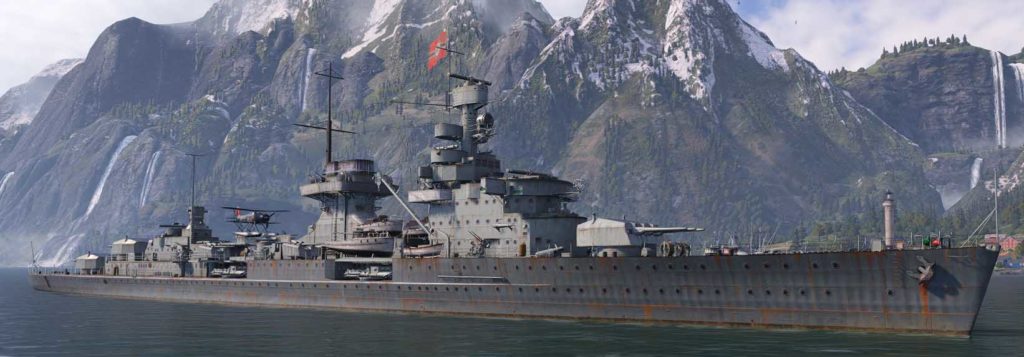
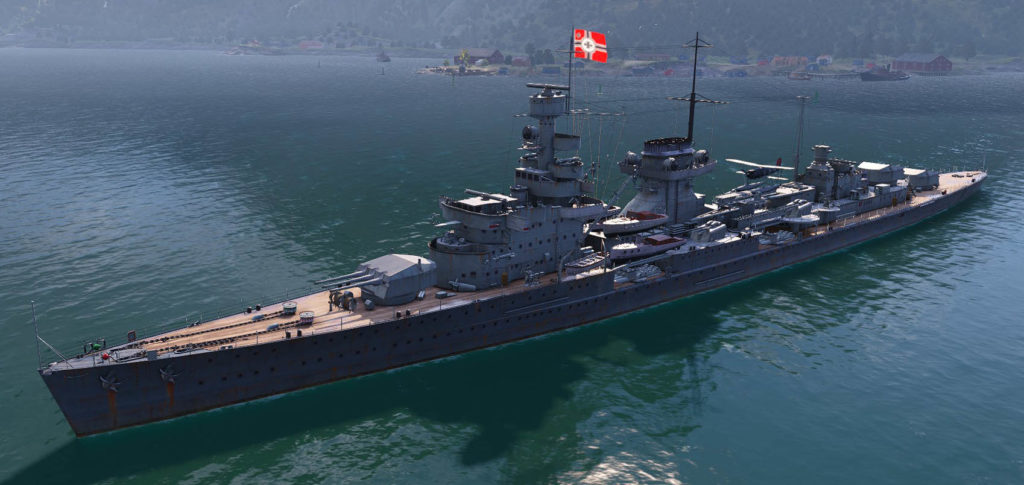
Wow’s renditions of the KMS Nürnberg class
Armament
Armament was the same at least for the main artillery, with three triple turrets but arrangement was different (more rationale and arguably much better). AA was limited to just two 8.8 cm (3.46″) SK L/45 anti-aircraft guns (It was the 1930s after all), like the K class, and close combat capabilities bolstered by four triple torpedo tubes, two per broadside, also on both classes, however the modified Nürnberg had 21 inches (533 mm) torpedoes instead of 20 inches (500 mm) and a better AA as revised.
So overall, larger vessels, less autonomy, slight protection improvements, main artillery management, but the best improvement of the class was to carry two Arado 196 floatplanes for reconnaissance. This truly made them “eyes” for the fleet.
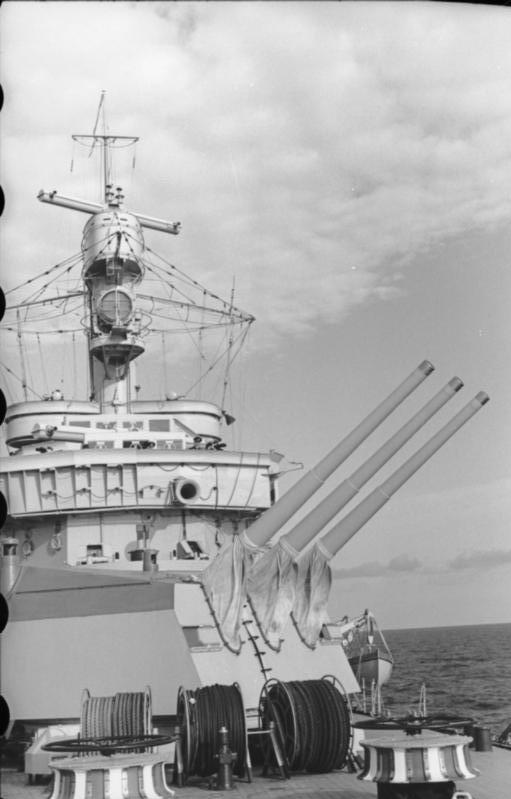
KMS Nürnberg forward turret at max elevation
Main guns:
Both ships shared the same nine 15 cm (5.9″) SK C/25 guns. They were designed from 1927 with a loose barrel, jacket and breech-piece with a vertical sliding breech block. They shared also the same Drh. LC/25 triple mounting, a unique case in the Kriegsmarine. This mount weighed 136.91–147.15 tonnes, for 20–30 mm (0.79–1.18 in) armour thickness, the latter figure being for the better armoured Nürnberg’s (80 mm face). They had a full 360° of traverse, reduced by the ship’s superstructure, a point the longer Leipzig corrected. As a reminder, to resolve the issue, the “K” clas had aft offset turrets. One was mounted on the forward deck, and two in superfiring position aft, all centerline, and keeping the gravity point low.
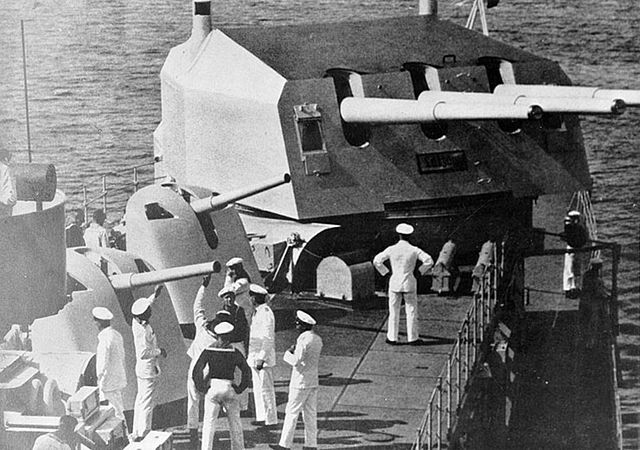
Aft superfiring turret of the Königsberg, similar.
The mounts had electrically powered hydraulic pumps for elevation, at the rate of 8° per second, and traverse at 6-8° per second. Their rate of fire (cyclic) was about, 7.5 seconds, an excellent 8 rounds per minute. This was indeed surprisingly good for manually loaded and rammed guns. To avoid interference, the three guns fired at a fraction of a second interval in volleys. The ammunition was supplied by three hoists at the rear of the mount. They fired four types of ammunitions: The base-fused HE shell with ballistic cap called Sprenggranate L/4.5 m Bdz m. Hb, the nose-fused HE shell with ballistic cap 15 cm Spgr. L/4.4 Kz m. Hb and a base-fused armor-piercing shell with ballistic cap Panzer-Sprenggranate L/3.7 m Bdz. m Hb, all three weighting 45.5 kg for 960 m/s muzzle velocity, and 25,700 metres (28,100 yd) range at 40°, as well as an illumination shell. Both ships carried 120 and 166 shells per gun, so 1,080 and 1,500 rounds total, respectively.
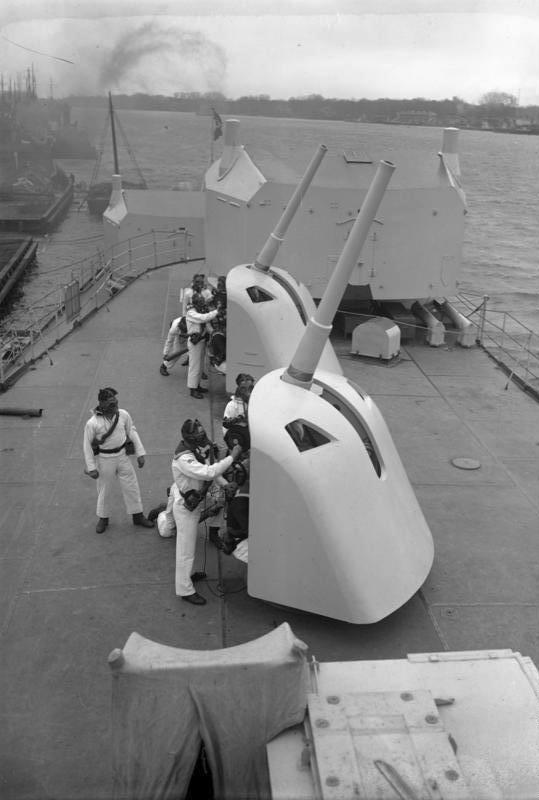
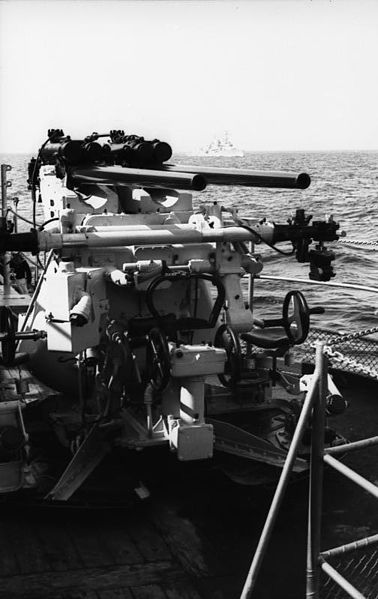
The FLAK was considerably reinforced during WW2. Here, on KMS Nürnberg.
Secondary guns and AA
Initially, all these cruisers carried just two traditional 8.8 cm SK L/45 naval gun. L was for “länge” and SK for Schnelladekanone (Quick firing). Basically they were derived from WW1 models, and its lineage with go through WW2 as one of the most fearsome artillery pieces of all times. They were protected by an armoured, rounded shield, weighted 2.5-2.8 tonnes and needed crew of four to operate. They used a Breech vertical sliding-wedge system and fired a 9–10 kgs (20–22 lb) 3.5 in shell. The SKC/30 mount elevated -10° to +70° and its rate of fire was about 15 RPM, with a muzzle velocity up to 890 m/s (2,900 ft/s), a range of 14,100 metres (15,400 yd) at +43° and ceiling of 9,150 metres (30,020 ft) at 70° elevation. They fired four types of ammunitions, the Armor Piercing (AP) – 10 kg (22 lb), High Explosive (HE) – 9 kg (20 lb), High Explosive Incendiary (HEI) – 9.5 kg (21 lb) and Illumination (ILLUM) shell, 9.4 kg (21 lb). KMS Leipzig carried 800 rounds of ammunition.
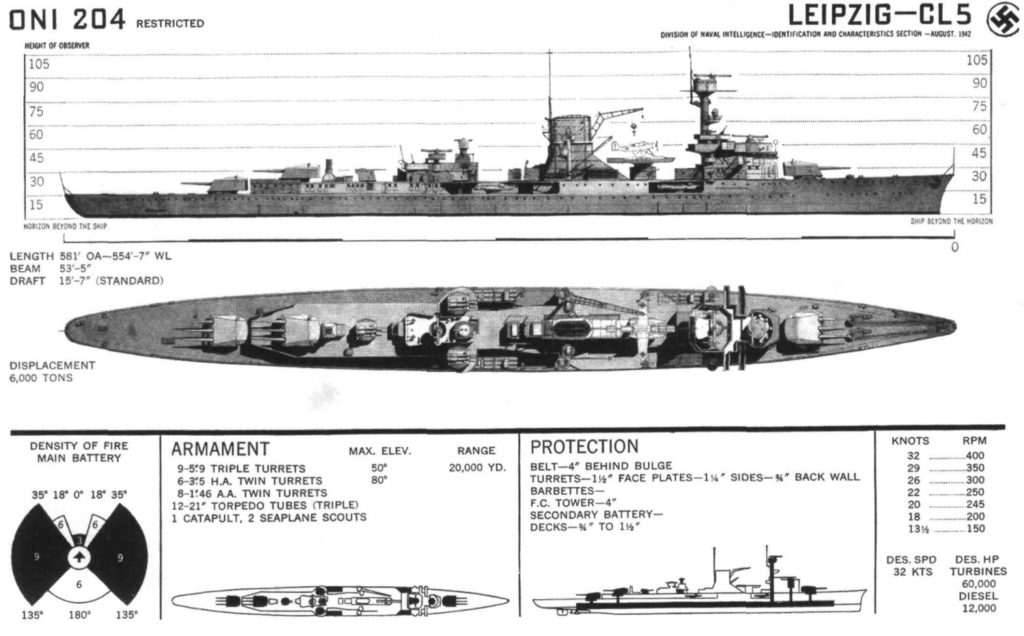
ONI recoignition sheet for the Leipzig
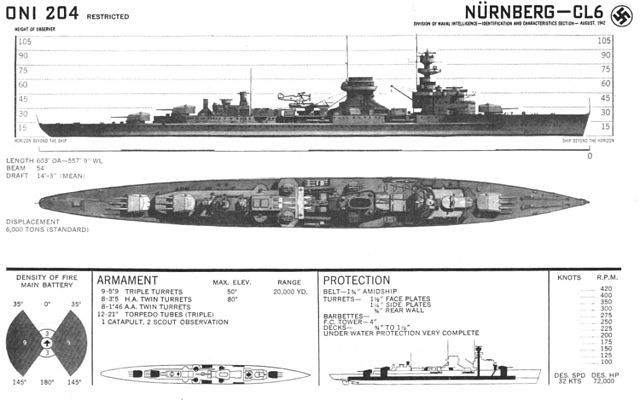
ONI recoignition sheet for the Nürnberg
KMS Nürnberg however received a number of modifications: Not only her torpedo tubes were upgraded to the new 21-in standard G7 model, but her anti-aircraft artillery was considerably enhanced, and this alone separated her from her sister-ship: Instead of just two 8.8 cm AA guns she had eight, and in addition four twin 3.7 cm SK C/30 guns and eight single 2 cm C/30 guns. Therefore during WW2 these figures barely changed. Only Leipzig received additions (see later).
Both ships had a similar profile with a single funnel, but Nürnberg had a much larger and blocky forward superstructure. Leipzig’s onw superstructure was just derived from the Königsberg class. Nürnberg added around the funnel a large searchlight platform to improve their night firing capabilities. The crew also varied on both ships (notably because of the AA), Leipzig in peacetime reichsmarine service having 26 officers and 508 enlisted men, but 24 officers and 826 sailors in WW2, and the admiral staff if needed, 6 officers, 20 men as flagship. Nürnberg had 25 officers and 648 ratings but this grew to 26 officers and 870 sailors.
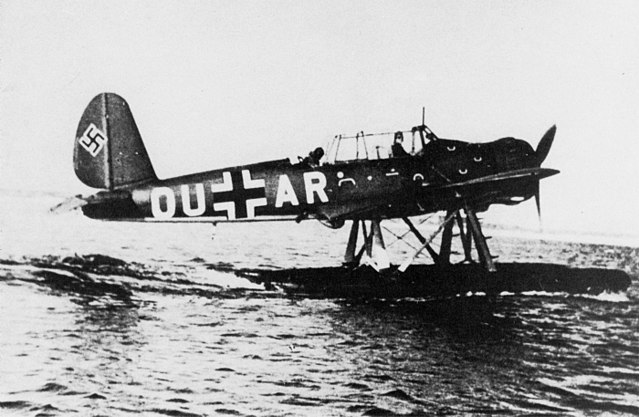
Arado 196, perhaps the only justification to the ship’s larger design. These floatplanes designed by Walter Blume first flew in 1937 and became the standard cantilever monoplanes of the Kriegsmarine, propelled by a BMW 132K 9-cyl. ACR of 947 hp. More than 540 were produced, armed with defensive MGs and two 20 mm (0.787 in) MG FF cannon, plus bombs. At first the cruisers operated a pair of Heinkel He 60 biplane floatplanes, replaced by the Arado Ar 196 by 1939. They were operated by a single catapult which diverged in position between the two ships: Between the funnel and the forward superstructure for Leipzig, aft of the funnel for her sister ship.
Wartime modifications
Both cruisers were rapidly given a degaussing coil to protect them against magnetic mines. KMS Leipzig saw her aircraft, and catapult removed in 1941 and torpedo tubes while radar was installed. Nürnberg had the same modifications in early 1942. Both cruisers radar suites were upgraded, at first in March 1941 a FuMO 21 radar set, in early 1942, a FuMO 25 for detection of surface targets and low-flying aircraft, short range. The FuMO 63 Hohentwiel 50-cm radar was installed later, while KMS Nürnberg was given four Metox radar warning receivers. Leipzig received the 24/25 radar set in early 1943, her last wartime modification.
Leipzig’s anti-aircraft armament was first upgraded by firring twin 8.8 cm mounts and from 1941, eight 37 mm FLAK guns in four twin mounts were installed as well as fourteen 2 cm individual guns. This was reduced in 1944 to eight. Nürnberg’s AA battery was already impressive, but she received in late 1942 two quadruple 2 cm Flakvierling mounts, on the navigating bridge and on top of the aft superfiring turret. By May 1944, there was a proposal to add several Bofors 40 mm guns, but just two were added, on the bridge and former catapult spot. Two more Navy Flakvierlings were added, replacing the one over the superfiring turret, and another in front of the AA fire director, while the Army Flakvierlings they replaced were relocated on the main deck. By December 1944, it was proposed to add eight 3.7 cm FlaK 43, two more Flakvierling and ten 20 mm twin guns, but other priorities prevented it.

Author’s illustration: KMS Leipzig

Author’s illustration: KMS Nürnberg
KMS Nürnberg specifications |
|
| Dimensions | 177 x 16.30 x 5.65 m |
| Displacement | 6200 t/8380 t FL |
| Crew | 1150 |
| Propulsion | 2 screws, 2 Brown-Boveri turbines, 66,000 hp, 2 MAN diesels 12 400 hp |
| Speed | 32/19 knots (xx km/h; xx mph) Radius 5700 Nautical Miles |
| Armament | 9(3×3)x 152 mm, 6x 88 mm AA, 8x 37mm AA, 12(4×3) TT 533 mm, 120 mines, 2 planes |
| Armor | Belt: 30 mm (), Deck: 25 mm (), Turrets 30mm, Conning tower: 30 mm () |
First Published on 2016/07/22
Sources/read More
Gardiner, Robert; Chesneau, Roger: Conway’s All the World’s Fighting Ships, 1922–1946.
Gröner, Erich (1990). German Warships: 1815–1945. Vol. I: Major Surface Vessels.
Rohwer, Jürgen (2005). Chronology of the War at Sea 1939–1945
Whitley, M. J. (1983). Lesser Known Warships of the Kriegsmarine No. 1/2
Williamson, Gordon (2003). German Light Cruisers 1939–1945.
Die 8,8 cm Flugzeugabwehrkanone L/45 (8,8 cm Flak. L/45) in 8,8 cm Mittel-Pivot-Lafette C/1913 (8,8 cm M.P.L.C./1913).
Gander, Terry; Chamberlain, Peter (1979). Weapons of the Third Reich
Hogg, Ian V. (1997). German Artillery of World War Two
(maritime-executive.com) Leipzig rediscovered off Norway
The Leizpig class cruisers in action:
Both cuisers participated in non-intervention patrols during the Spanish Civil War until 1937. From September 1939 they were both used as minelayers and for escort duties, but barely two months after the war started, 13 December 1939, they were torpedoed by the HMS Salmon, a British sub. Thos “double kill” failed to sink them due to their good ASW protection, but the Kriegsmarine avoid exposing them thereafter and they were kept for secondary roles, notably training, although Leipzig brought close artillery support to the troops on the Eastern Front.
Nürnberg became a war prize for the Soviet Navy, starting a new but shot career as Admiral Makarov, until the late fifties, BU 1960.
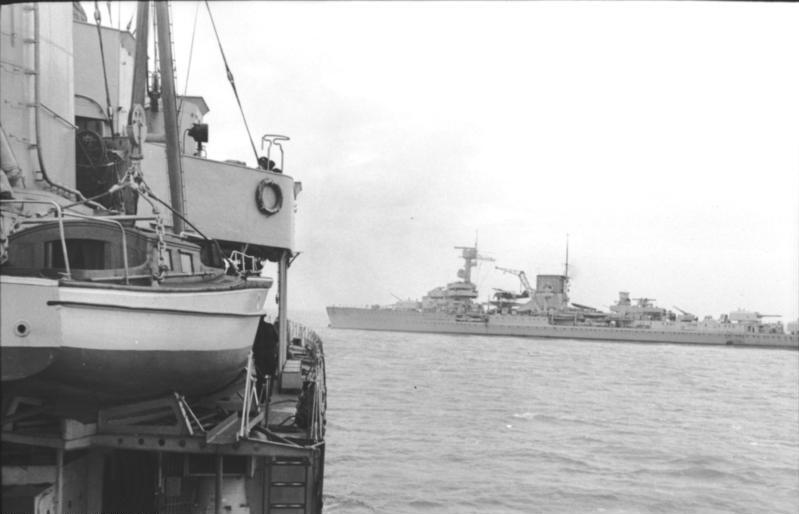
Cruiser Leipzig seen from the Kaiser-Wilhelm-Kanal
KmS Leipzig
Reichsmarine and interwar years
Leipzig was laid down at the Reichsmarinewerft shipyard, Wilhelmshaven on 28 April 1928, launched on 18 October 1929 and commissioned on 8 October 1931. So far she served in the Reichsmarine, training in the Baltic Sea throughout until 1933 and alternating with overseas goodwill cruises. In 1934 she sailed with Königsberg to the United States for the first time, but later entered the drydock at Kiel to received an aircraft catapult and crane while the old single 8.8 cm were replaced with modern twin AA mounts, bringing to total to four. In 1935 she joined the the old Schlesien, Deutschland, and Köln for fleet exercises wans was visited by Adolf Hitler later that year. In 1936, she also teamed with Nürnberg and Köln for exercises in the Atlantic and in the summer, took part in neutrality patrols off Spain as the Civil War broke out. These patrols went on until the next summer 1937. In late June, her captain reported an incident: She was allegedly torpedo attacked ny Republicans. Decision was therefore made to retite all ships patrolling in Spanish waters. Leipzeig was back to Baltic Sea for training until the end of 1938. In March 1939, the annexation of Memel from Lithuania took place, covered by her guns and from other ships. In April she joined KMS Gneisenau and Deutschland, for major exercises in the Atlantic, assumed to be the last before a war erupted, until May-June.
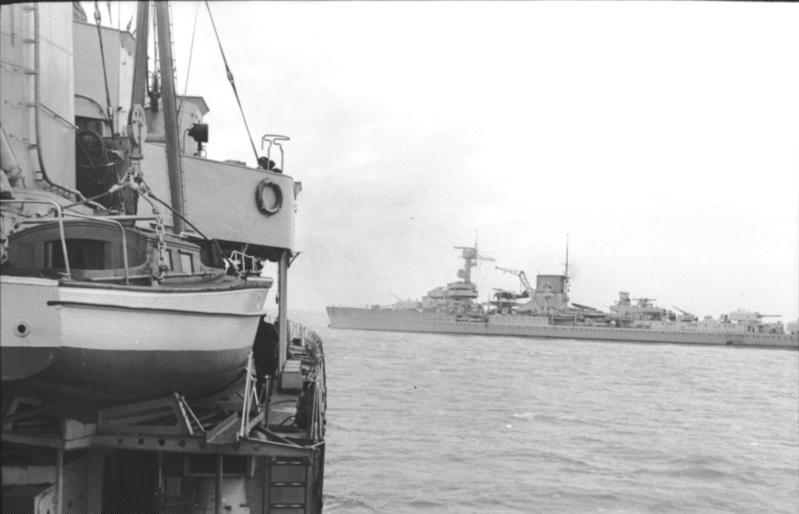
KMS Leipzig photography, entering the Kaiser Wilhelm Canal.
Wartime career
By September 1939, KMS Leipzig joined the blocking force placed to prevent the escape of the Polish Navy, but it missed it, as Operation Peking took place. She then joined the North Sea,to assist other light cruisers by laying several defensive minefields until the end of the month. She then took part in Baltic training exercises and by mid-November, covered another minelaying operation in the North Sea. She was added to a small raiding task force composed of the Deutschland, Köln, and three torpedo boats, to try to disrupt allied shipping in the Skagerrak on 21–22 November. Later, KMS Leipzig escorting Scharnhorst and Gneisenau through the Denark strait for another raid, and covered their return on the november, 27.
On 13 December, she escorted destroyers and minelayers through the Skagerrak for laying more minefields, but was spotted en route by British submarine HMS Salmon, plaed there in ambush. HMS Salmon launch a torpedo volley, then another, and ht the Leipzig at 11:25, just below the waterline. Fortunately for the cruiser, her bulkhead absorbed the shock at the juncture of boiler rooms. But the armored deck was bented and the keel als damaged while 1,700 t of seawater flooded her. The electrical power and pumping system stopped, two boiler rooms were submerged, steam lines damaged, and port turbine stopped. Nürnberg also a hit. The former was immediately assisted by two destroyers, closing to port, while the others gave chase. One hour passed and one destroyer was torpedoed off the mouth of the Elbe while Leipzig had a near-miss. If the second torpedp had made its mark, the cruiser would probably had been sunk.
Leipzig limped back to Kiel, entered the Deutsche Werke shipyard for very long repairs, decommissioned and later reclassified as a training ship. Apparenty the Kriegsmarine did not wanted to risk her more. Plans were made for transformations: A new superstructure was to be built to accommodate trainees while four boilers were removed to gain more room. She was recommissioned in late 1940, missing te Norwegian campaign. Until early June 1941 she trained cadets, and then departed for an escort mission, conducting the heavy cruiser Lützow to Norway. Back in the Baltic she she teamed with Emden to shell Russians positions along the path of invading German forces during Operation Barbarossa. By September 1941, she covered the invasion of the Baltic islands, West Estonian archipelago, shelling Soviet positions on Moon Island. At this occasion, the Soviet submarine Shch-317 was nearby and tried to attack her but missed. By late September, she teamed with the German Baltic Fleet (flagship Tirpitz) assembled to stop any Soviet attempt to break out of the Baltic. She was back to Kiel in October for manoeuvrers with Admiral Scheer and she became the flagship of the training fleet by 1942.
KMS Leipzig was taken in hands in March 1943 for a short overhaul and she was back to escort ships in the Baltic by mid-September 1944. She covered troopships between Gotenhafen and Swinemünde with Admiral Scheer on 14 October, also to take mines there. However there was a heavy fog, she collided heavy cruiser Prinz Eugen, steaming at 20 knots. Just when she was hit, Leipzig was switching from her diesel to steam turbines, caught uncoupling the former, so she had no means of propulsion and was drifting into the path of Prinz Eugen. She was struck on her port side, just forward of her funnel, the heavy cruiser’s clipper bow stucking out beyond the starboard side. The number 3 port engine room was destroyed, another was flooded and the ship had 39 deaed of injured crewmen. Both ships remained stuck together for more than 24h until Leipzig was towed off her misery to Gotenhafen. There, a commission examined the damage, judged too severe for repairs. She was only patched to remain afloat in the harbor, waiting for better times.
The cruiser however was still commissioned, and provided AA fire by March 1945, as the Red Army closed on Gotenhafen. On 24 March, she steamed to Hela, packed with refugees, at 6 knots (11 km/h; 6.9 mph) with her remaining boilers. During this harrowing trip she was repeatedly attacked by Soviet aviation, and near-missed by torpedoes from two submarines. She reached Denmark on 29 April, waiting the end of the war. She was subsequently used as a barracks ship for the German Mine Sweeping Administration after the war. The latter were tasked by the allies to clear mines off the German coast. Leipzig was eventually towed out and scuttled at sea in July 1946 to create an artificial reef.
KmS Nürnberg
Nürnberg was laid down in 1934 at Deutsche Werke Kiel, launched 6 December 1934, completed and commissioned on 2 November 1935. She started by a training cruise in the Baltic Sea which lasted until April 1936, joining Köln and Leipzig for another cruiser in the Atlantic. She became the flagship of the reconnaissance forces and served also in the Baltic in a serie of exercises. Like her sister ship, KMS Nürnberg made non-intervention patrols off the Spanish coast during Civil War, until 1939, under order of Konteradmiral Hermann Boehm. She conducted four patrols without incident but the report of a possible attack by an unidentified submarine off the Balearic Islands, 16 July 1937.
By September 1937, KMS Nürnberg was participating in fleet manoeuvres with KMS Admiral Graf Spee and Deutschland, her sister ship and Karlsruhe. In early 1938 she was in the Baltic, and during the summer made training cruise to Norway. By August, she participated in the Kiel fleet review in presence of Adolf Hitler and the regent of Hungary, Miklós Horthy. In March 1939 she cover and operation to seize Memel and later joined Graf Spee, Leipzig and Köln for a training cruise in the Mediterranean, stopping at various Spanish ports. From May 1939 she was training in the Baltic.
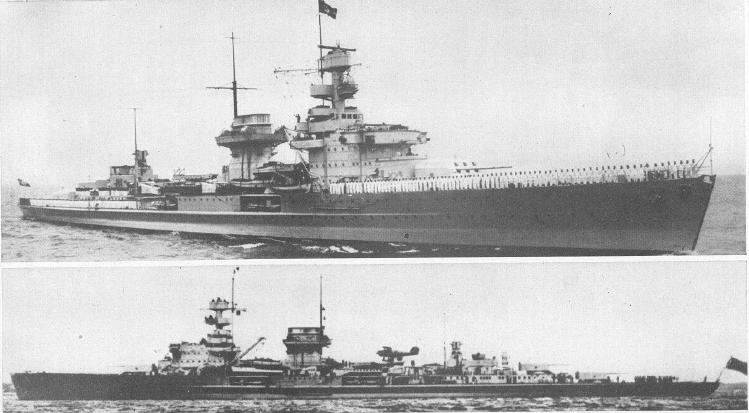
Nürnberg, recoignition book (ONI ?)
Wartime career
In September 1939, KMS Nürnberg was sent to the force in charge of intercepting the Polish Navy escaping from the Baltic, but failed. Two days later, the German light cruiser followed the fleet to the North Sea laying defensive minefields in order to secure the coastline. Back to the Baltic she resumed her training exercises routine the next month and in November she was back to the North Sea to cover this time a squadron of destroyers laying minefields off the British coast. By early December, she took part in another minelaying mission off Kristiansand (Norway).
However as she was escorting on 13 December the destroyers back from another minelaying mission off the British coast, HMS Salmon watited in ambush, and launch torpedoes. Nürnberg watchmen spotted in time two torpedo tracks ahd the captaine turned hard to port, evading one ahead of the ship, but the second hit her bow. The captain order to nearly stop at 12 knots in order to inspect the damage. At this moment HMS Salmon has reloaded and launched yet another spray, three more torpedo tracks being spotted to port. Order was given to full speed and hard starboard turn, but two torpedoes exploded its wake, short of the stern. The explosion caused flooding no damage as the watertight bulkheads absorbed the schock. At last the HMS Salmon was spotted and briefly engaged by Nürnberg, firing her aft main battery turret but scoring no hit. She limped back to port at 18 knots but en route was attacked again by another British submarine, HMS Ursula on 14 December as she was entering the Kiel Canal off Brunsbüttel. Immediately placed in drydock at Deutsche Werke her repairs lasted until April 1940.
Kapitän zur See (KzS) Otto Klüber took command in June 1940, and the ship was mobilized for Operation Juno, Gneisenau and Scharnhorst raid. But this was cancelled later and instead, she was transferred to Norway. She left Kiel on 10 June, escorted by the TBs Falke and Jaguar and two days later left her TBs to refuel at Stavanger while she steamed in zig-zag at 27 knots by fear of other submarines, joining on 13 June the 2nd Minesweeper Flotilla. KMS Nünberg escorted them off Trondheim and on 17 June she reached Narvik. She spent the whole month of July there. One of her two Arado Ar 196 floatplane spotted and attacked a British submarine, without sucess, the only action there. By 25 July, she was ordered with a flotilla of destroyers and torpedo boats to escort the damaged battleship Gneisenau from Trondheim to Kiel, which they reached on 28 July. Indeed Gneisenau was torpedoed by the British submarine.
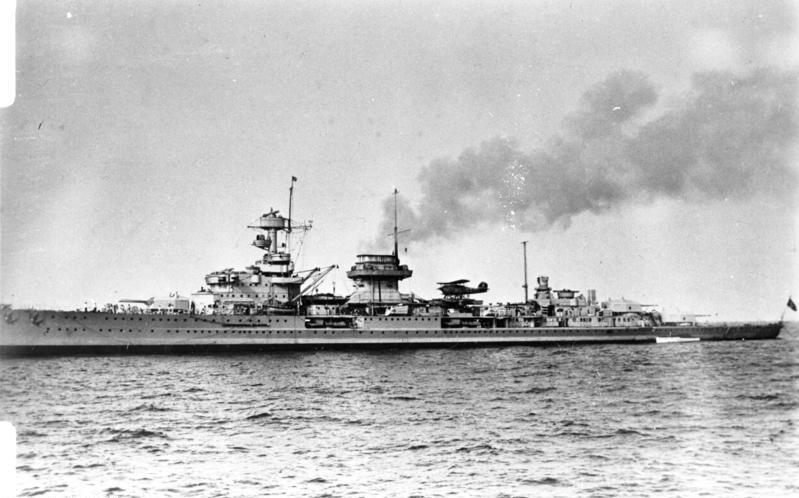
KMS Nürnberg underway, date unknown
By 8 August, KzS Leo Kreisch took command and until the end of 1940, KMS Nünberg spent training in the Baltic sea. She was visited while in Gotenhafen by Italian Admiral Mavagini in September 1940 and entered Deutsche Werke dockyard for a short refit in October-November 1940. On 15 February 1941 it was decided by the Kriegsmarine staff to reclassify her as a training cruiser like her sister ship. She was assigned to the Fleet Training Squadron, tasked to train future U-boat officers in order to crew the numerous flotillas built to be engaged in the Battle of the Atlantic. Part of her crew also became U-Boat crewmen. However by June 1941, she had the occasion to be useful again. Sent to the Baltic Fleet task force headed by the new battleship KMS Tirpitz she was tasked to wait for a possible sortie of the Soviet Baltic fleet. Ultimately as this scenario never materialized, the fleet was dispersed and Nürnberg resumed her training until 1942. In January she was refitted, aircraft removed, radar modernized, AA expanded. She was damaged during an allied air raid and was repaired, returning into service only by 23 August.
After sea trials lasting until October 1942 she was sent to the flotilla based in Norway, departing on 11 November Gotenhafen for Trondheim (18 November), then she was moved to a less exposed position, Bogen Bay, outside Narvik in December. A new fleet was headed by Tirpitz again, to raid nortern allied convoys, bound to Murmansk. The German light cruiser however saw no action and on 27 April 1943 she left Narvik for home, stopping at Trondheim. Back in Kiel on 3 May she entered the drydock to have her machinery overhauled and later after new sea trials, she joined the Training Squadron in the Baltic, having her crew amputated and replaced quite frequently. On board discipline and esprit de corps was low, but she kept her duty all along the year 1944 seeing no action, not even shore bombardment on the Eastern Front like her sister ship.
Early in 1945 she was sent for another minelaying mission in the Skagerrak, based in Oslo. She participated in Operation Titus on 13 January, covering two destroyers, two torpedo boats, and a minelayer and she laid herself 130 mines. As fuel shortages amounted, U-Boats had priority and she was not active afterwards. On 24 January, she was sent to Copenhagen (Denmark), remaining here until the end of the hostility; For the anecdote, the fuel situation was so bad that her tanks were filled with 270 long tons (270 t) of synthetic fuel in case she had to move. Her crew was also reduced to the strict operating minimum. By 5 May 1945 she was ordered to stop military operation and on 22 May, she was escorted by HMS Devonshire and HMS Dido to enter custody under allied supervision, and await her fate.
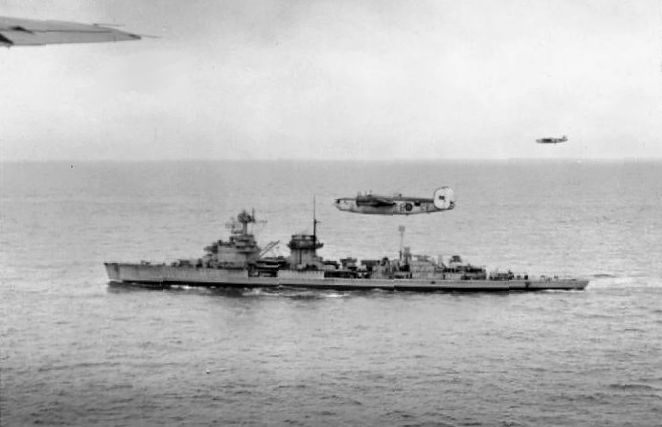
Nürnberg surrendering to the allies in May 1945: She is escorted by a Coastal Command (RAF) Consolidated Liberator patrol bomber.
Post War service
On 24 May 1945, Nürnberg and Prinz Eugen departed Copenhagen to Wilhelmshaven, which they reached on 28 May. As decided in the Potsdam Conference she was awarded to the Soviet Union. The allies however still remembering the 1919 scuttling, both vessels were seized by British crews on 19 December. KMS Nürnberg was by then in drydock. The same day, they were presented to a Soviet delegation, and handed over officially. On 2 January a Soviet crew arrive and prepare the ship for a departure. The prize flotilla comprised also the target ship Hessen and her radio-control vessel, a single destroyer, Z15, the torpedo boats T33 and T107. They departed for Libau (Latvia).
As they arrived a trough examination was made by Soviet engineers, which estimated she was fit for service. She entered commission under the new name of Admiral Makarov. He first assignation was the 8th Fleet in Tallinn. By late 1948 she became its flagship, carrying the mark of Vice Admiral F. V. Zozulya. However as new Chapayev-class cruisers entered service, it was decided to remove Admiral Makarov from the 8th fleet. She became a training cruiser based in Kronstadt, starting this new career by mid-1954. Her German light AA was removed, and new Soviet-built radars installed. Records showed she was no longer in service by May 1959, mothballed and scrapped around 1963-65, by that time the last surviving warship of the Kriegsmarine, but not the last German major warship, the record being detained by TGC Yavuz, the ex-Goeben, in 1971.



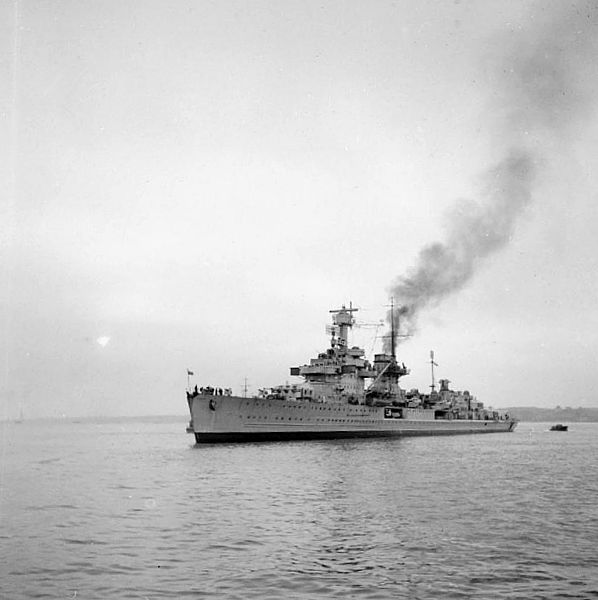
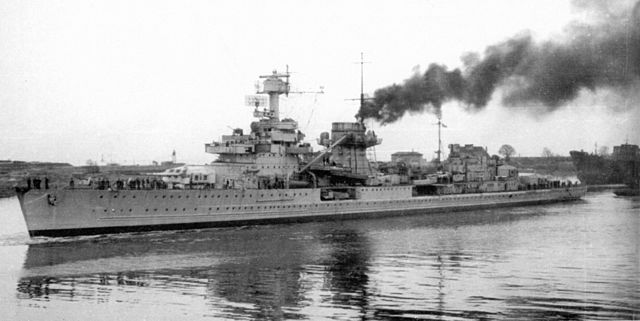
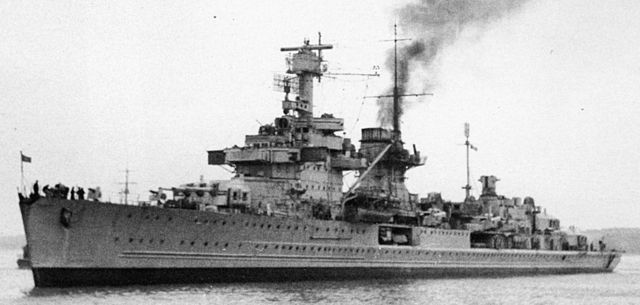
 Latest Facebook Entry -
Latest Facebook Entry -  X(Tweeter) Naval Encyclopedia's deck archive
X(Tweeter) Naval Encyclopedia's deck archive Instagram (@navalencyc)
Instagram (@navalencyc)





 French Navy
French Navy Royal Navy
Royal Navy Russian Navy
Russian Navy Armada Espanola
Armada Espanola Austrian Navy
Austrian Navy K.u.K. Kriegsmarine
K.u.K. Kriegsmarine Dansk Marine
Dansk Marine Nautiko Hellenon
Nautiko Hellenon Koninklije Marine 1870
Koninklije Marine 1870 Marinha do Brasil
Marinha do Brasil Osmanlı Donanması
Osmanlı Donanması Marina Do Peru
Marina Do Peru Marinha do Portugal
Marinha do Portugal Regia Marina 1870
Regia Marina 1870 Nihhon Kaigun 1870
Nihhon Kaigun 1870 Preußische Marine 1870
Preußische Marine 1870 Russkiy Flot 1870
Russkiy Flot 1870 Svenska marinen
Svenska marinen Søværnet
Søværnet Union Navy
Union Navy Confederate Navy
Confederate Navy Armada de Argentina
Armada de Argentina Imperial Chinese Navy
Imperial Chinese Navy Marinha do Portugal
Marinha do Portugal Mexico
Mexico Kaiserliche Marine
Kaiserliche Marine 1898 US Navy
1898 US Navy Sovietskiy Flot
Sovietskiy Flot Royal Canadian Navy
Royal Canadian Navy Royal Australian Navy
Royal Australian Navy RNZN Fleet
RNZN Fleet Chinese Navy 1937
Chinese Navy 1937 Kriegsmarine
Kriegsmarine Chilean Navy
Chilean Navy Danish Navy
Danish Navy Finnish Navy
Finnish Navy Hellenic Navy
Hellenic Navy Polish Navy
Polish Navy Romanian Navy
Romanian Navy Turkish Navy
Turkish Navy Royal Yugoslav Navy
Royal Yugoslav Navy Royal Thai Navy
Royal Thai Navy Minor Navies
Minor Navies Albania
Albania Austria
Austria Belgium
Belgium Columbia
Columbia Costa Rica
Costa Rica Cuba
Cuba Czechoslovakia
Czechoslovakia Dominican Republic
Dominican Republic Haiti
Haiti Hungary
Hungary Honduras
Honduras Estonia
Estonia Iceland
Iceland Eire
Eire Equador
Equador Iran
Iran Iraq
Iraq Latvia
Latvia Liberia
Liberia Lithuania
Lithuania Mandchukuo
Mandchukuo Morocco
Morocco Nicaragua
Nicaragua Persia
Persia San Salvador
San Salvador Sarawak
Sarawak Uruguay
Uruguay Venezuela
Venezuela Zanzibar
Zanzibar Warsaw Pact Navies
Warsaw Pact Navies Bulgaria
Bulgaria Hungary
Hungary

 Bundesmarine
Bundesmarine Dutch Navy
Dutch Navy Hellenic Navy
Hellenic Navy Marina Militare
Marina Militare Yugoslav Navy
Yugoslav Navy Chinese Navy
Chinese Navy Indian Navy
Indian Navy Indonesian Navy
Indonesian Navy JMSDF
JMSDF North Korean Navy
North Korean Navy Pakistani Navy
Pakistani Navy Philippines Navy
Philippines Navy ROKN
ROKN Rep. of Singapore Navy
Rep. of Singapore Navy Taiwanese Navy
Taiwanese Navy IDF Navy
IDF Navy Saudi Navy
Saudi Navy Royal New Zealand Navy
Royal New Zealand Navy Egyptian Navy
Egyptian Navy South African Navy
South African Navy






























 Ukrainian Navy
Ukrainian Navy dbodesign
dbodesign